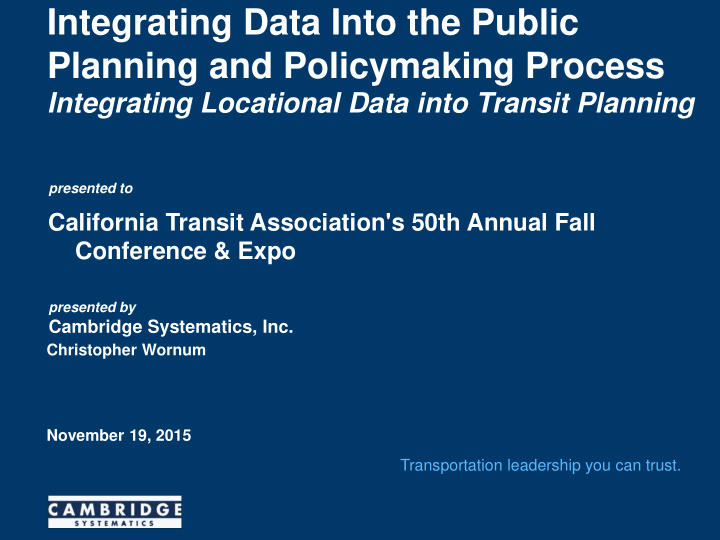



Integrating Data Into the Public Planning and Policymaking Process Integrating Locational Data into Transit Planning presented to California Transit Association's 50th Annual Fall Conference & Expo presented by Cambridge Systematics, Inc. Christopher Wornum November 19, 2015 Transportation leadership you can trust.
Big data is like teenage sex… Everyone talks about it, Nobody really knows how to do it, Everyone thinks everyone else is doing it, ….so everyone claims they are doing it.
Can Cell Phone Data Replace Travel Diary Survey Significant Challenges Remain, but May Be Resolved Expanding survey data to represent population » Vender expansion methods are proprietary & very much a black box » Android phones over represented in low income population, Manhattan is 70%-plus Apple, other boroughs are opposite distribution Lack individual socioeconomic data » Must rely only on aggregate socioeconomic data based on the imputed household location. » Must expand based on individual rather than household Trip-Making Bias » Incorrect stop determination, » Cell phone owners not carrying their devices, or » Multiple devices assigned to each owner. Temporal Bias » Home & work location determined by time of day » Inaccurate for 24/7 shift-based industrial and service industries. 3
Spatial Bias Key benefits of GPS compared to cellular 5 m 250 m 2,000 m 4
Locational Bias Key benefits of GPS compared to cellular 2.4 hours 10 time per day I minute 144 minutes 30 times per minute 5
Major Providers and Public Validation Sources Publicly Available Data Proprietary Data Providers AirSage Census Transportation Planning Package (CTPP), Streetlight HERE National Household Travel Survey (NHTS), INRIX Highway Performance TomTom Monitoring System ( HPMS) Nokia (NEXT) Strava Freight Analysis Framework (FAF). TRANSEARCH 6
GPS vs. Cellular Data Key benefits of GPS compared to cellular: » High spatial precision, incl. for road segments (5m vs. 250-2000m). » High frequency rate (30x/min vs. 10x/day) » Ability to separate personal from commercial travel » Non-motorized modes (walk, bike) from Strava » Calibration tests using license plate scanner data » Data set growing and improving every day. Key detriments of GPS compared to cellular: » More sampling skews, especially towards wealthier and unfamiliar trips (more on how we correct later). » No differentiations between transit and auto. » No long-time patterning, meaning we can’t identify what ‘tourists’ do when they’re visiting. 7
Cost AirSage Example Number of days 1 Day Year(s) Geographic coverage Small city State(s) Granularity Zip code Census block group) Trip purposes No distinction 9 trip purposes Data totaled or averaged Weekly average Individual daily totals Time of day/periods Daily total 5 day parts Census information None Income, age Type of travel None Resident, visitor, commuter Price Range $10,000 8
Model Validation on Trip Distribution Distribution of Trips from San Joaquin County 20% 18% 16% 14% 12% 10% 8% 6% 4% 2% 0% 9 2011 Air Sage 2013 ACTC 2013 ACTC before Adjustments
Understanding Travel Markets for Transit Three Travel Markets through Tri-Valley Origins Destinations San Joaquin Valley BART & Amtrak Stations < ½ < ½ mile ile ½ to 5 o 5 mile iles > 5 5 m miles ~10% ~30% ~60% 10
Regional Transit Markets Limited First Mile/Last Mile Passenger Collection & Distribution 11
US 101 South Speeds, Evening Rush Hour Without HOV Lane New HOV Lane 2 PM 4 PM 6 PM 8 PM 2 PM 4 PM 6 PM 8 PM (detectors down, I-280 to I-80) (detectors down, I-280 to I-80) Direction of Travel
Recommend
More recommend